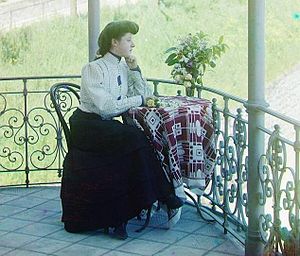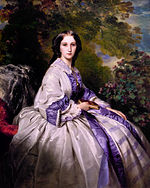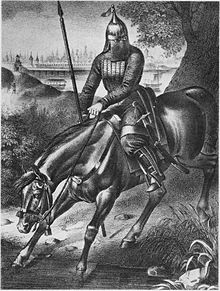- Russian nobility
-
The Russian nobility (Russian: Дворянство Dvoryanstvo) arose in the 14th century and essentially governed Russia until the October Revolution of 1917.
The Russian word for nobility, Dvoryanstvo (дворянство), derives from the Russian word dvor (двор), meaning the Court of a prince or duke (kniaz) and later, of the tsar. A nobleman is called dvoryanin (pl. dvoryane). As in other countries, nobility was a status, a social category, but not a title.
Contents
Categories
Nobility was transferred by inheritance or was bestowed by a fount of honour.
- Ancient nobility—which the descendants of Rurik and Gediminas and boyars inherited: e.g., the Shuyskies, Galitzins, Naryshkins, Khilkoffs, Gorchakovs, Belosselsky-Belozerskys and Chelyadnins.
- Titled nobility—there were three titles:
- Prince (knyaz Князь): e.g., Prince Potemkin or Prince Felix Yusupov
- Count (graf Граф): e.g., Count Tolstoy
- Baron (baron Барон): e.g., Baron Pahlen
- Hereditary nobility— routinely inherited by heirs
- Personal nobility—granted for the personal merits of the recipient.
- Unpropertied nobility—was obtained without the allotment and securing of a landed estate.
Unlike the ancient nobility, which was exclusively hereditary, the remaining classes of nobility could be acquired. A newly designated noble was usually entitled to landownership. A loss of land did not automatically mean loss of nobility. In later Imperial Russia, higher ranks of state service (see Table of Ranks) were automatically granted nobility, not necessarily associated with landownership.
Titled nobility (титулованное дворянство) was the highest category: those who had titles such as prince, count and baron. The latter two titles were introduced by Peter the Great. A baron or count could be either proprietary (actual) ( владетельный (действительный))—i.e., who owned land in the Russian Empire—or titular (титулярный), i.e., only endowed with the title.
Hereditary nobility (потомственное дворянство) was transferred to wife, children, and further direct legal descendants along the male line. In exceptional cases, the emperor could transfer nobility along indirect or female lines, e.g., to preserve a notable family name.
Personal nobility (личное дворянство) was transferable only to the wife and was of much lower prestige.
Unpropertied nobility (беспоместное дворянство) was nobility gained by state service, but which was not entitled to land ownership.
In addition, the ancient nobility (Древнее дворянство) was recognized, descendants of historical boyars and knyazes.
Russian did not employ a nobiliary particle (as von in German or de in French) before a surname, but Russian noblemen were accorded an official salutation that varied by their ranks: your nobility (ваше благородие), your high nobility (ваше высокоблагородие), your high ancestry (ваше высокородие), etc.
History
The nobility arose in the 12th and 13th centuries as the lowest part of the feudal military class, which composed the court of a prince or an important boyar. From the 14th century land ownership by nobles increased, and by the 17th century it composed the bulk of feudal lords and constituted the majority of landowners. They made Landed army (Russian: поместное войско) - the basic military force of Russia. Peter the Great finalized the status of the nobility, while abolishing the boyar title.
Tsarina Anna gave many privileges to the nobility. In 1730 she repealed the primogeniture law of Peter the Great so estates could be subdivided again. In 1736, the age when they had to start service was raised from 15 to 20, service was now for 25 years not life and families with more than one son could keep one to manage the estate.[1]
In 1762 Peter III abolished compulsory military service for nobles. Marc Raeff (Origins of the Russian Intelligentsia) has suggested this was not a noble victory but a sign the state didn't need them as much now that they had plenty of trained officials. Catherine the Great gave away 66,000 serfs 1762-72, 202,000 1773-93 and 100,000 in one day: 18 August 1795.[2] Thus she was able to bind the nobility to her. From 1782, a kind of uniform was introduced for civilian nobles called uniform of civilian service or simply civilian uniform. The uniform prescribed colors that depended on the territory. The uniform was required at the places of service, at the Court, and at other important public places. The privileges of the nobility were fixed and were legally codified in 1785 in the Charter to the Gentry. The Charter introduced an organization of the nobility: every province (guberniya) and district (uyezd) had an Assembly of Nobility. The chair of an Assembly was called Province/District Marshal of Nobility. In 1831 Nicholas I restricted the assembly votes to those with over 100 serfs, leaving 21,916 voters.[3]
By 1805, the various ranks of the nobility had become confused, as is apparent in War and Peace. Here, we see counts who are wealthier and more important than princes. We see many noble families whose wealth has been dissipated, partly through lack of primogeniture and partly through extravagance and poor estate management. We see young noblemen serving in the Army, but we see none who acquire new landed estates that way. (This refers to the era of the Napoleonic Wars. Tolstoy reported some improvement afterwards: some nobles paid more attention to estate management, and some, like Andrey Bolkonsky, freed their serfs even before the tsar did so in 1861.)[4] 62.8% of Russia's nobles were szlachta from the 9 western gubernii in 1858 and still 46.1% in 1897.[5]
Serfs owned by European Russian landlords
No. of serfs 1777 % 1859 % +1000 1.1 501-1000 2 101-500 16 (101+) 18 21-100 25 35.1 -20 59 43.8 Obrok or cash rent was most common in the north while barshchina or labour rent was found mainly in the southern Black Earth Region. In Nicholas I's reign the latter brought three times the income of cash rent though this needed less administration.[7] In 1798, Ukrainian landlords were banned from selling serfs apart from land. In 1841, landless nobles were banned also.[8]
The nobility was too weak to oppose the emancipation of the serfs. In 1820 a fifth of the serfs were mortgaged, half by 1842.[9] By 1859, a third of noble's estates and two thirds of their serfs were mortgaged to noble banks or the state.[10] The nobility was also weakened by the scattering of their estates, lack of Primogeniture and the high turnover and mobility from estate to estate.
Year % nobles in landowner families 1861 80 1877 72 1895 55 1905 39 1912 36 After the peasant reform of 1861 the economic position of the nobility was weakened. The influence of nobility was further reduced by the new law statutes of 1864, under which their right of electing law officers was repealed. The reform of the police in 1862 limited the landowners authority locally, and creation of all-estate Zemstvo local government did away with exclusive influence of nobility in local self-government.
This was despite the fact that the nobles kept nearly all the meadows and forests, had their debts paid by the state while the ex serfs paid 34% over the market price for the shrunken plots they kept. This figure was 90% in the northern regions, 20% in the black earth region but zero in the Polish provinces. In 1857, 6.79% of serfs were domestic, landless servants who stayed landless after 1861.[12] Only Polish and Romanian domestic serfs got land. 90% of the serfs who got larger plots were in the 8 ex Polish provinces where the Tsar wanted to weaken the Szlachta. The other 10% was in Astrakhan and the barren north.[13] In the whole Empire, peasant land declined 4.1%,13.3% outside the ex Polish zone and 23.3% in the 16 black earth provinces.[14] Georgia's serfs suffered the loss of 1/5 of their land in Tiflis province, 1/3 in Kutaisi province.[15] These redemption payments were not abolished till January 1, 1907.
The influx of New World grain caused a slump in grain prices,forcing the peasants to farm more land. At the same time, despite their efficiency, large peasant households split up (from 9.5 to 6.8 persons per household in central Russia, 1861–84).[16] The resulting land hunger increased prices 7 fold and made it easier for nobles to sell or rent land rather than farm it themselves. From 1861 to 1900 40% of noble land was sold to peasants (70% of this went to the Commune [17] and by 1900 two thirds of the nobles' arable land was rented to the peasantry.[18] 1900–1914, over 20% of remaining noble land was sold but only 3% of the 155 estates over 50,000 desiatiny.[19] According to the 1897 census,71% of the top 4 rans of the civil service were nobles.[20] But in the civil service as a whole,noble membership declined from 49.8% in 1755 to 43.7% in the 1850s and 30.7% in 1897.[21] There were 1.2million nobles, about 1% of the population (8% in Poland,4% in Hungary and 1-1.5% in France).[22] Their military influence waned: in the Crimean War 90% of officers were noble, by 1913 it was 50%.[23] They lived increasingly away from estates: in 1858only 15-20% of Russian nobleslived in cities, by 1897 it was 47.2%.[24]
Year % 1861 noble land still in their control 1867 96.3 1872 92.6 1877 88.4 1882 81.7 1887 76.7 1892 72.4 1897 67.1 1902 61 1905 58.8 1909 52.3 1913 47.6 1914 47.1 By 1904 1/3 noble land was mortgaged to the noble bank.[26] During the 1905 Russian Revolution 3,000 manors were burnt (15% of the total).[27]
Year Noble land (desiatinas) 1861 105,000,000 1877 73,077,000 1905 52,104,000 After the October Revolution of 1917 all classes of nobility were legally abolished. Many members of the Russian nobility who fled Russia after the Bolshevik Revolution played a significant role in the White Emigre communities that settled in Europe, in North America, and in other parts of the world. In the 1920s and 1930s, several Russian nobility associations were established outside Russia, including groups in France, Belgium, and the United States. In New York, the Russian Nobility Association in America was founded in 1938. Since the collapse of the Soviet Union, there has been a growing interest among Russians in the role that the Russian nobility has played in the historical and cultural development of Russia.
Acquisition of nobility
Nobility could be acquired by several means, including military service.
Between 1722 and 1845 hereditary nobility was bestowed on long-serving military officers, civil servants who attained the 8th rank of Collegiate Assessor, as well as any person who received any grade within an order of the Russian Empire.
Between 1845 and 1856 hereditary nobility was bestowed for long service at the 5th rank of major and State Counsellor and to all recipients of the Order of Saint George, the Order of Saint Vladimir, the Order of Saint Anne, and the Order of Saint Stanislaus.
From 1856, hereditary nobility was given to those who rose to the 4th rank of colonel, captain of the first rank, and actual state counsellor, as well as to all recipients of the Order of Saint George,the Order of White Eagle, the Order of Saint Vladimir, the award 'first class' of the Order of Saint Anne and the award 'first class' of the Order of Saint Stanislaus.
Later, automatic entitlement to the rank of hereditary nobility was further restricted. Only a recipient of the award of 'first class' (grade) of any order of Russian Empire, and (from 1900) the order of Order of Saint Vladimir of the third class (or higher), could become an hereditary noble. Those awarded lesser grades within the orders of Russian Empire, or receiving one of the lesser grades in the Order of Saint Vladimir, might attain personal nobility.
Privileges of the nobility
Russian nobility possessed the following privileges:
- The right to own estates populated with estate-tied serfs (until 1861), including virtual ownership of the serfs who worked on the estates.
- Freedom from compulsory military service (1762–1874; later compulsory military service was introduced which did not exempt the noble estate)
- Freedom from zemstvo duties (until the second half of 19th century)
- The right to enter specially designated educational institutions (Tsarskoye Selo Lyceum, School of Jurisprudence and Page Corps)
- Freedom from corporal punishment.
- The right to bear and use a coat of arms, introduced by the end of the 17th century.
See also
References
- Official site of the Principal Russian Nobility Association
- The Russian Nobility Association in America
- Official site of the Imperial House of Russia
- ^ Richard Pipes, Russia under the old regime, page 133
- ^ Richard Pipes, Russia under the old regime, page 119
- ^ Richard Pipes, Russia under the old regime, page 179
- ^ Tolstoy, Leo.War and Peace. (Translated by Richard Pavear and Larissa Volokonsky, 2007)
- ^ Seymour Becker, Nobility and Privilege in late Imperial Russia, page 182
- ^ Richard Pipes, Russia under the old regime, page 178
- ^ Dominic Lieven, The Aristocracy in Europe,page 39.
- ^ Geroid Tanquary Robinson, Rural Russia under the old régime: a history of the landlord-peasant world, page 37
- ^ Geoffrey Hosking, Russia: People and Empire, page 164
- ^ Orlando Figes, A People's Tragedy,page 48
- ^ Seymour Becker, Nobility and privilege in late imperial Russia, page 29
- ^ Donald Wallace, Russia vol. II, page 145
- ^ Geroid Robinson, Rural Russia under the old regime, page 88.
- ^ Jerome Blum, The end of the old order in Europe,page 395
- ^ Ronald Suny, The making of the Georgian nation, page 107
- ^ Orlando Figes, A People's Tragedy, page 92
- ^ Seymour Becker,Nobility and privilege in late imperial Russia,page 36
- ^ Orlando Figes, A People's Tragedy, page 48
- ^ Dominic Lieven,The Cambridge History of Russia vol. II page 232
- ^ Orlando Figes, A People's Tragedy, page 36
- ^ Seymour Becker, Nobility and privilege in late imperial Russia, page 109
- ^ Dominic Lieven, The Cambridge History of Russia vol. II page 230
- ^ Dominic Lieven, The Aristocracy in Europe,page 182
- ^ Seymour Becker, Nobility and privilege in late imperial Russia, page 28
- ^ Seymour Becker,Nobility and privilege in late imperial Russia,page 32
- ^ Geroid Robinson, Rural Russia under the old regime, page 131.
- ^ Orlando Figes, A People's tragedy, page 181
- ^ Geroid Robinson, Rural Russia under the old regime, pp 63, 131 .
Categories:
Wikimedia Foundation. 2010.



